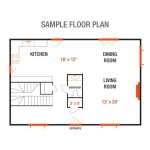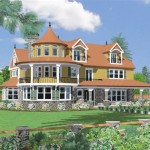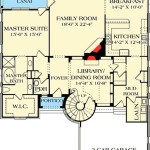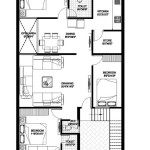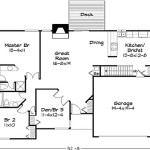Tiny Home Floor Plans: Exploring 2-Bedroom Options
The tiny home movement has gained significant momentum, appealing to individuals and families seeking simplified living, reduced environmental impact, and financial freedom. While the term "tiny" suggests limitations, creative architectural designs and floor plans are proving that comfortable and functional living spaces can be achieved within a smaller footprint. Among the various tiny home configurations, the 2-bedroom layout is particularly attractive for small families, couples who desire a guest room or home office, or individuals seeking dedicated space for hobbies or storage.
Designing a 2-bedroom tiny home requires careful consideration of space optimization, multi-functional furniture, and efficient use of vertical space. It's not simply about shrinking a standard home; it's about reimagining how to live comfortably and effectively in a condensed environment. Several floor plan options cater to different needs and preferences, each with its own set of advantages and disadvantages.
Before delving into specific floor plans, it's crucial to understand the factors influencing the design choices. The size of the home, whether it's built on a trailer or a foundation, the local building codes, and the occupants' lifestyle all play a significant role in determining the most suitable layout. The availability of natural light, the orientation of the home, and the climate are also important considerations that impact the overall comfort and energy efficiency of the living space.
Key Considerations for Designing a 2-Bedroom Tiny Home
Designing a 2-bedroom tiny home involves several critical considerations that go beyond simply fitting two bedrooms into a small space. Maximizing functionality, ensuring privacy, and maintaining a sense of spaciousness are key challenges that designers must address.
One primary concern is the placement of the bedrooms. Ideally, bedrooms should offer some degree of privacy and separation from the main living area. In some designs, bedrooms might be located at opposite ends of the home, while in others, one bedroom might be placed on a loft level to create separation. The choice depends on the overall layout and the desired level of privacy.
Another factor to consider is storage. Tiny homes inherently lack storage space, so it is essential to incorporate creative storage solutions throughout the design. This might involve utilizing vertical space with shelving and cabinets, integrating storage compartments under beds and seating, and utilizing multi-functional furniture that serves multiple purposes.
Ventilation and natural light are also crucial for maintaining a comfortable and healthy living environment. Large windows and skylights can help to brighten the space and improve air circulation. Proper insulation is also essential for regulating temperature and minimizing energy consumption.
Finally, accessibility is an important consideration, especially for individuals with mobility issues. Loft spaces, while useful for adding sleeping or storage areas, may not be suitable for everyone. Therefore, designers should consider incorporating ground-floor bedroom options or making the loft accessible via a sturdy staircase rather than a ladder.
Common 2-Bedroom Tiny Home Floor Plan Options
Several common floor plan configurations can be adapted to create a comfortable and functional 2-bedroom tiny home. Each option offers unique advantages and caters to different lifestyle needs.
Loft-Based Design: This is perhaps the most prevalent design, leveraging vertical space to create separate sleeping areas. Typically, one bedroom is located on the ground floor, while the second bedroom is situated in a loft area accessible via a ladder or staircase. The ground floor bedroom may serve as the master bedroom, while the loft area can be used as a guest bedroom, children's room, or home office. This design maximizes the use of floor space and creates a sense of separation between the sleeping areas. However, access to the loft can be challenging for some individuals, and the sloping roof can limit headroom.
Ground-Floor Bedrooms with Compact Living Space: This design prioritizes ground-floor living and features two compact bedrooms on the main level, typically located at opposite ends of the home. The living area, kitchen, and bathroom are situated in the center. This layout is ideal for individuals who prefer to avoid climbing stairs or ladders. However, it requires careful space planning to ensure that the bedrooms are adequately sized and that the living area remains functional and comfortable. This model can sometimes compromise on living room space to accommodate two bedrooms on a single level.
Two-Story Design: While less common due to its increased complexity and cost, a two-story tiny home can provide a more spacious and conventional living experience. This design features two bedrooms on the upper level and a living area, kitchen, and bathroom on the ground floor. This configuration offers greater separation between living and sleeping areas and allows for larger bedrooms. However, it requires a larger footprint and may not be suitable for all locations. Furthermore, building codes might impose stricter requirements for two-story structures.
Hybrid Designs: Many designers are creating hybrid designs that combine elements of the above options. For example, a design might feature one ground-floor bedroom and a smaller loft area for a second bedroom or storage. These hybrid designs allow for greater flexibility and can be tailored to the specific needs of the occupants.
Optimizing Space in a 2-Bedroom Tiny Home
Regardless of the chosen floor plan, optimizing space is crucial for creating a functional and comfortable 2-bedroom tiny home. Clever design solutions and multi-functional furniture can make a significant difference in maximizing the available space.
Multi-Functional Furniture: Furniture that serves multiple purposes is essential for tiny home living. Sofa beds, fold-down tables, and storage ottomans can help to maximize space and minimize clutter. Beds with built-in storage drawers underneath are also a great way to utilize otherwise wasted space. Consider a dining table that can be folded away when not in use or a coffee table that can be raised to become a dining table.
Vertical Storage: Utilizing vertical space is another key strategy for maximizing storage in a tiny home. Tall cabinets, shelves, and wall-mounted organizers can provide ample storage without taking up valuable floor space. Consider installing shelves above doorways or using vertical space in closets to create additional storage areas. Magnetic knife strips on the kitchen wall, hanging pot racks, and pegboards can also free up drawer and cabinet space.
Hidden Storage Compartments: Integrating hidden storage compartments into the design can also help to maximize space. For example, a platform bed with a hinged top can provide storage space under the mattress. Benches with lift-up seats can also be used to store blankets, pillows, or other items. Another tip is to design stairs with built-in drawers or shelving, which can be particularly useful for storing shoes, books, or small appliances.
Open Shelving: While cabinets can provide enclosed storage, open shelving can create a sense of spaciousness and lightness in a tiny home. Use open shelves to display books, plants, or decorative items, thereby adding personality to the space. Consider using clear storage containers to keep items organized and visible on open shelves, creating an organized and aesthetically pleasing look. Floating shelves are also a good option, as they don't take up floor space and can be easily installed.
Pocket Doors and Sliding Doors: Traditional swinging doors can take up valuable floor space. Pocket doors, which slide into the wall, and sliding doors, which slide along the wall, can help to save space and improve traffic flow. Utilize these door types for bedrooms and bathrooms to maximize living area.
Mirrors: Strategically placed mirrors can create the illusion of more space and reflect natural light, making the tiny home feel brighter and more open. Consider placing a large mirror on a wall or using mirrored cabinet doors. Also, ensuring that mirrors face a light source will maximize their effect on the interior illumination.
Creating a functional and comfortable 2-bedroom tiny home is a design challenge that requires careful planning, creative solutions, and a commitment to simplified living. By carefully considering the key factors influencing the design, exploring the available floor plan options, and optimizing space through multi-functional furniture and clever storage solutions, it is possible to create a tiny home that meets the needs and preferences of its occupants without sacrificing comfort or functionality.

The Best 2 Bedroom Tiny House Plans Houseplans Blog Com

2 Bedroom Tiny House Plans Blog Eplans Com

2 Bedroom Tiny House Floor Plan

The Best 2 Bedroom Tiny House Plans Houseplans Blog Com

Tiny House Plans For Families The Life Floor Cabin

2 Bedroom Tiny House Floor Plan

2 Bedroom Tiny House Plans Blog Eplans Com

The Best 2 Bedroom Tiny House Plans Houseplans Blog Com

Two Bedroom Tiny Modern House Plan 22456dr Architectural Designs Plans

20x32 Tiny House 2 Bedroom 1 Bath 640 Sq Ft Floor Plan Instant Model


